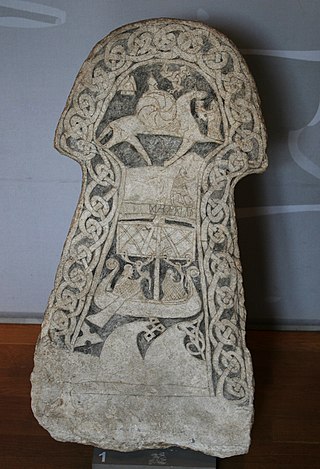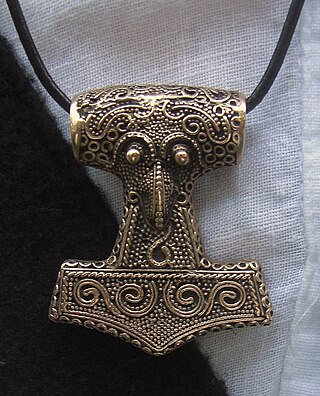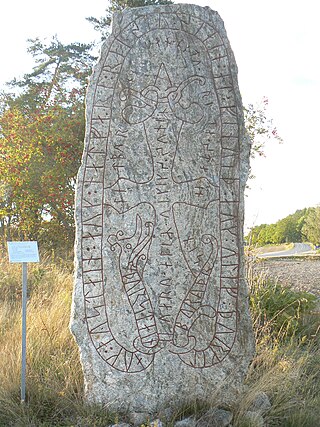
Bragi is the skaldic god of poetry in Norse mythology.

Freyr, sometimes anglicized as Frey, is a widely attested god in Norse mythology, associated with kingship, fertility, peace, prosperity, fair weather, and good harvest. Freyr, sometimes referred to as Yngvi-Freyr, was especially associated with Sweden and seen as an ancestor of the Swedish royal house. According to Adam of Bremen, Freyr was associated with peace and pleasure, and was represented with a phallic statue in the Temple at Uppsala. According to Snorri Sturluson, Freyr was "the most renowned of the æsir", and was venerated for good harvest and peace.
A kenning is a figure of speech in the type of circumlocution, a compound that employs figurative language in place of a more concrete single-word noun. Kennings are strongly associated with Old Norse-Icelandic and Old English alliterative verse. They continued to be a feature of Icelandic poetry for centuries, together with the closely related heiti.

In Norse mythology, a valkyrie is one of a host of female figures who guide souls of the dead to the god Odin's hall Valhalla. There, the deceased warriors become einherjar. When the einherjar are not preparing for the events of Ragnarök, the valkyries bear them mead. Valkyries also appear as lovers of heroes and other mortals, where they are sometimes described as the daughters of royalty, sometimes accompanied by ravens and sometimes connected to swans or horses.

Old Norse religion, also known as Norse paganism, is a branch of Germanic religion which developed during the Proto-Norse period, when the North Germanic peoples separated into a distinct branch of the Germanic peoples. It was replaced by Christianity and forgotten during the Christianisation of Scandinavia. Scholars reconstruct aspects of North Germanic Religion by historical linguistics, archaeology, toponymy, and records left by North Germanic peoples, such as runic inscriptions in the Younger Futhark, a distinctly North Germanic extension of the runic alphabet. Numerous Old Norse works dated to the 13th-century record Norse mythology, a component of North Germanic religion.
Jutlandic, or Jutish, is the western variety of Danish, spoken on the peninsula of Jutland in Denmark.

Labeling theory posits that self-identity and the behavior of individuals may be determined or influenced by the terms used to describe or classify them. It is associated with the concepts of self-fulfilling prophecy and stereotyping. Labeling theory holds that deviance is not inherent in an act, but instead focuses on the tendency of majorities to negatively label minorities or those seen as deviant from standard cultural norms. The theory was prominent during the 1960s and 1970s, and some modified versions of the theory have developed and are still currently popular. Stigma is defined as a powerfully negative label that changes a person's self-concept and social identity.

The Spanish language employs a wide range of swear words that vary between Spanish speaking nations and in regions and subcultures of each nation. Idiomatic expressions, particularly profanity, are not always directly translatable into other languages, and so most of the English translations offered in this article are very rough and most likely do not reflect the full meaning of the expression they intend to translate.[c]

Heathenry, also termed Heathenism, contemporary Germanic Paganism, or Germanic Neopaganism, is a modern Pagan religion. Scholars of religious studies classify it as a new religious movement. Developed in Europe during the early 20th century, its practitioners model it on the pre-Christian religions adhered to by the Germanic peoples of the Iron Age and Early Middle Ages. In an attempt to reconstruct these past belief systems, Heathenry uses surviving historical, archaeological, and folkloric evidence as a basis, although approaches to this material vary considerably.
Medieval Scandinavian law, also called North Germanic law, was a subset of Germanic law practiced by North Germanic peoples. It was originally memorized by lawspeakers, but after the end of the Viking Age they were committed to writing, mostly by Christian monks after the Christianization of Scandinavia. Initially, they were geographically limited to minor jurisdictions (lögsögur), and the Bjarkey laws concerned various merchant towns, but later there were laws that applied to entire Scandinavian kingdoms. Each jurisdiction was governed by an assembly of free men, called a þing.
In historical Germanic society, nīþ was a term for a social stigma implying the loss of honour and the status of a villain. A person affected with the stigma is a nīðing . Middle English retained a cognate nithe, meaning 'envy', 'hate', or 'malice'.

Viking is the name of the son of Vífil and Eimyrja in Þorsteins saga Víkingssonar. Viking is the father of Thorsten and Thorer. Further details of his legend are recounted in Frithiof's Saga.
The Greece runestones are about 30 runestones containing information related to voyages made by Norsemen to the Byzantine Empire. They were made during the Viking Age until about 1100 and were engraved in the Old Norse language with Scandinavian runes. All the stones have been found in modern-day Sweden, the majority in Uppland and Södermanland. Most were inscribed in memory of members of the Varangian Guard who never returned home, but a few inscriptions mention men who returned with wealth, and a boulder in Ed was engraved on the orders of a former officer of the Guard.
The Viking runestones are runestones that mention Scandinavians who participated in Viking expeditions. This article treats the runestone that refer to people who took part in voyages abroad, in western Europe, and stones that mention men who were Viking warriors and/or died while travelling in the West. However, it is likely that all of them do not mention men who took part in pillaging. The inscriptions were all engraved in Old Norse with the Younger Futhark. The runestones are unevenly distributed in Scandinavia: Denmark has 250 runestones, Norway has 50 while Iceland has none. Sweden has as many as between 1,700 and 2,500 depending on definition. The Swedish district of Uppland has the highest concentration with as many as 1,196 inscriptions in stone, whereas Södermanland is second with 391.

Odin is a widely revered god in Germanic paganism. Norse mythology, the source of most surviving information about him, associates him with wisdom, healing, death, royalty, the gallows, knowledge, war, battle, victory, sorcery, poetry, frenzy, and the runic alphabet, and depicts him as the husband of the goddess Frigg. In wider Germanic mythology and paganism, the god was also known in Old English as Wōden, in Old Saxon as Uuôden, in Old Dutch as Wuodan, in Old Frisian as Wêda, and in Old High German as Wuotan, all ultimately stemming from the Proto-Germanic theonym *Wōðanaz, meaning 'lord of frenzy', or 'leader of the possessed'.
Ragnhild Tregagås or Tregagás was a Norwegian woman from Bergen. From 1324 to 1325, Tregagås was accused and convicted of exercising witchcraft and selling her soul to the devil. She was "accused of performing magical rituals of a harmful nature, demonism and heresy" as well as the crimes of adultery and incest with her cousin, Bård. She was sentenced to strict fasting and a seven-year-long pilgrimage to holy places outside of Norway by Bishopp Audfinn Sigurdsson, as documented in his proclamation "De quaddam lapsa in heresim Ragnhild Tregagås" and the sentencing "Alia in eodem crimine". It is likely that Ragnhild Tregagås held a higher social position in Bergen, as the Bishop dealt with her personally and did not sentence her to death. There is little documentation on who Ragnhild Tregagås was as a person. Due to the date of her trial, it is likely that she was born in the late 13th century. There is also no recorded death date for Ragnhild Tregagås. She was married, her husband's name is undocumented, and he died before the trial, likely unaware of his wife's adultery. The trial against Ragnhild Tregagås is the only one concerning witchcraft that is known from medieval Norway, taking place 250 years before the witch-hunt in Norway started.

The Rus', also known as Russes, were a people in early medieval Eastern Europe. The scholarly consensus holds that they were originally Norsemen, mainly originating from present-day Sweden, who settled and ruled along the river-routes between the Baltic and the Black Seas from around the 8th to 11th centuries AD. In the 9th century, they formed the state of Kievan Rusʹ, where the ruling Norsemen along with local Finnic tribes gradually assimilated into the East Slavic population, with Old East Slavic becoming the common spoken language. Old Norse remained familiar to the elite until their complete assimilation by the second half of the 11th century, and in rural areas, vestiges of Norse culture persisted as late as the 14th and early 15th centuries, particularly in the north.

LGBT themes in mythology occur in mythologies and religious narratives that include stories of romantic affection or sexuality between figures of the same sex or that feature divine actions that result in changes in gender. These myths are considered by some modern queer scholars to be forms of lesbian, gay, bisexual, or transgender (LGBT) expression, and modern conceptions of sexuality and gender have been retroactively applied to them. Many mythologies ascribe homosexuality and gender fluidity in humans to the action of gods or of other supernatural interventions.

In Old Norse, seiðr was a type of magic which was practised in Norse society during the Late Scandinavian Iron Age. The practice of seiðr is believed to be a form of magic which is related to both the telling and the shaping of the future. Connected to the Old Norse religion, its origins are largely unknown, and its practice gradually declined after the Christianization of Scandinavia. Accounts of seiðr later made it into sagas and other literary sources, while further evidence of it has been unearthed by archaeologists. Various scholars have debated the nature of seiðr, some of them have argued that it was shamanic in context, involving visionary journeys by its practitioners.
Swedish profanity can be divided into several categories. A substantial number of curse words in Swedish have religious origins. Euphemistic variants of the religious curses are commonly used as well. References to genitalia or bodily functions are common in the Swedish profanity vocabulary. Notably, no word for sexual intercourse is commonly used in invectives, unlike many other languages. However, calques of English fuck using knull (noun), knulla (verb) do occur; this comes across as more offensive than fuck does in English. In general, knull(a), along with genitalia slang words like kuk ('cock') and fitta ('cunt') are the most offensive single words. By contrast, most of the traditional religious profanities are not considered very offensive today; this is in line with Sweden's long-standing secularism.













